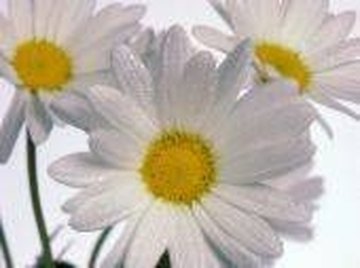
How do daisies reproduce and multiply? The answer to that question depends on the daisy you're interested in, as there are many types of daisies. Various daisy species have their own methods of reproduction, but these essentially boil down to two different strategies: asexual and sexual. While sexual reproduction in plants results in the production of seeds, asexual reproduction methods like division involve the separation of vegetative plant structures in order to produce more plants. All true daisies belong to the same family, Asteraceae, and they all have similar methods of sexual and asexual reproduction.
Types of Daisies
The common name "daisy" refers to several related types of plants. All members of the aster family, all types of daisy flowers have similar flowers, but their growth habits, soil preferences and climate requirements vary among the different species.
Perennials for sun include Shasta daisies (Leucanthemum x superbum) and oxeye daisies (Leucanthemum vulgare). English daisies (Bellis perennis L.) are low-growing species often found in lawns, and Gerbera daisies (Gerbera jamesonii) are colorful flowers that are often grown as bedding plants or in containers.
While different types of daisies have their own characteristics, uses and sunlight requirements, they are similar in the ways that they reproduce. Some daisies can use both asexual and sexual methods of reproduction.
Reproduction by Seed
Like all angiosperms, the reproductive organs of daisies are in the flowers. Daisies and other members of the aster family, like sunflowers, are called composite flowers. What looks like one flower is actually many small flowers clustered together to make a flower head.
Daisies and other members of the family Asteraceae are composed of two types of flowers: discs and rays. The discs are make up the center of the flower heads, while the ray flowers typically include a showy petal and make up the outer ring of the daisy flowers.
Within a daisy flower head, there are male and female flower parts. The first step in sexual daisy reproduction is pollination, which is when pollen is transferred from an anther, a male part, to a stigma, a female flower part. If the ovule of the flower is successfully fertilized by the pollen, a seed will begin to form in the flower.
Once daisy flower seeds ripen, they are distributed by the wind, animals and insects to nearby areas. If conditions are suitable, the seed will germinate and become the next generation of the daisy species. Shasta and oxeye daisies typically reproduce by seed, with one flower head often producing hundreds of seeds.
Asexual Reproduction of Daisies
In some daisy species, asexual modes of reproduction are common. English and Gerbera daisies sometimes multiply this way, although they can also reproduce by seed.
Plants that reproduce vegetatively, or asexually, often have specialized structures called rhizomes that grow below the ground, like modified roots. These rhizomes produce crowns, which are structures that grow above the ground. English daisies multiply prolifically by growing new crowns from nodes in their rhizomes, and mature Gerbera daisies can often be dug up, divided and replanted to produce more plants.
Some daisies will reproduce asexually with no help from a gardener, whether more plants are desired or not – which is often the case with English daisies, a species considered a weed by many people. Other species reproduce more slowly, like Gerbera daisies, and may be more desirable in gardens and containers.
Many types of daisies are prolific in the landscape because they often use more than one way to reproduce. Cheerful and colorful in the landscape, daisies brighten the places where they grow and multiply, whether it's a roadside, a cottage garden or the middle of a park.
References
About the Author
Meg Schader is a freelance writer and copyeditor. She holds a Bachelor of Science in agriculture from Cornell University and a Master of Professional Studies in environmental studies from SUNY College of Environmental Science and Forestry. Along with freelancing, she also runs a small farm with her family in Central New York.
Photo Credits
www.flickr.com, bulgar.no-ip.info, www.flickr.com, www.flickr.com
